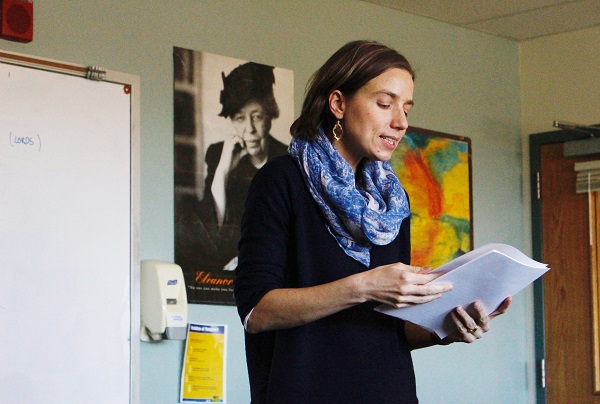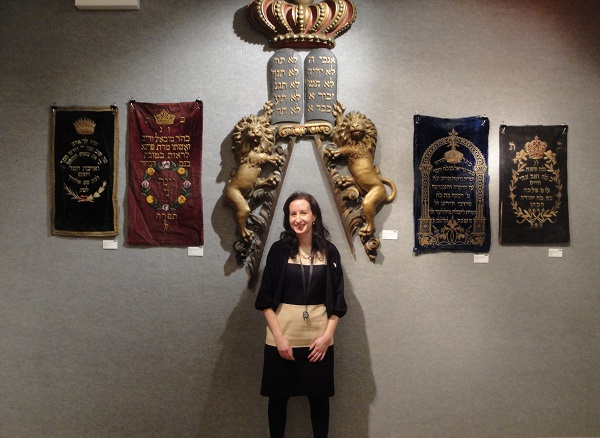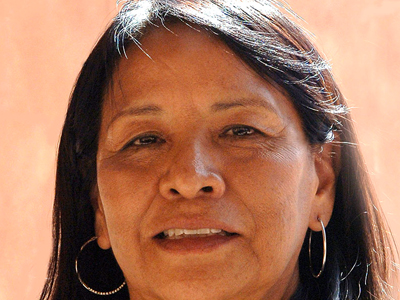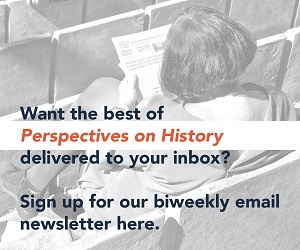Asking people for money probably isn’t most people’s first career goal. In fact, I cannot think of a single colleague of mine who dreamed of a fundraising career from childhood. Instead, we all come to it from circuitous paths—from marketing, business, or the arts. My story? I fell into fundraising from public history. And of everyone I know, my path was the most fortuitous: there is no better preparation for a career in fund development than public history.
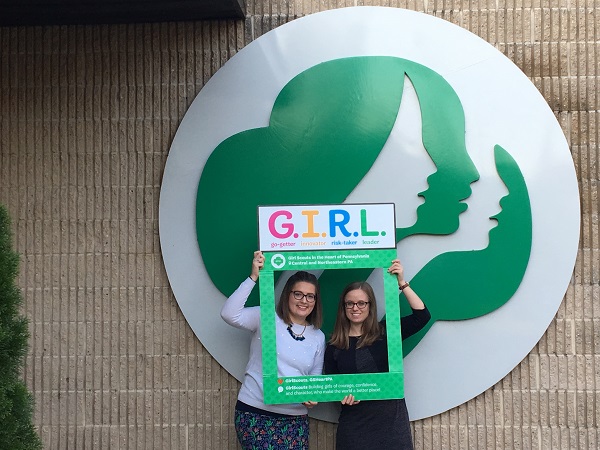
Katherine Garland (right) poses with her co-worker Lyndsey Mackie outside the Girl Scouts in the Heart of Pennsylvania office. Julie Queen
Of course, I did not enter public history expecting to become a fundraiser. After graduating in 2015 from the University of Massachusetts Amherst with a master’s degree in public history and a certificate in arts management, I went on the public history job market. To pay the bills, I took a part-time fundraising job at a personal care home. While there, I fell in love with fundraising, and my life changed forever.
Today I work for Girl Scouts in the Heart of Pennsylvania (GSHPA), raising money to support girls across the central and northeastern parts of the state. In my role as coordinator for strategic partnerships and donor relations, I write grant applications and annual appeals, facilitate programmatic partnerships with local businesses and organizations, and oversee our donor database. It’s a big job, and one that I succeed at because of, not in spite of, my background in public history.
Applying for grants is, of course, a natural career path for a historian. Researching and writing a well-crafted argument about the past is not that different from researching and writing a well-crafted grant proposal asking for financial support for a cause. Every day at my job, I find myself grateful for my historical training, for having learned to conduct research thoroughly, structure arguments purposefully, and choose words carefully. But the similarities between public history and fund development don’t end there.
Good public historians tell stories that tie facts together, breathing life into them, giving them meaning, and making them memorable. Good fundraisers do the same.
I could rattle off a number of facts about GSHPA—that we serve 17,500 girls, that 8,100 girls participated in STEM programming last year, and that more than 4,000 girls rely on financial assistance to participate in Girl Scouts annually. Numbers alone, however, are not especially compelling.
But eight-year-old Ashley’s story is. Ashley’s been through a lot in her short life. Her mother, father, and grandfather have all been incarcerated, and for a time she was living with her teenage aunt. Her life is difficult. But in the past two years, Ashley has found some stability thanks to Girl Scouts Beyond Bars, a unique program for girls whose mothers are incarcerated. In special troop meetings, Ashley and her mother do Girl Scouts together, learning to communicate with each other and rebuilding their relationship. Ashley also attends girl-only meetings, which give her a place to talk about her situation with a supportive community of girls who understand.
When asked about her favorite memories during a troop meeting, Ashley listed “Girl Scouts and when my mom was happy.” Girl Scouts is Ashley’s safe space, and it is as meaningful to her as those distant memories from before her mother was incarcerated. Most people will remember Ashley’s story for a lot longer than those statistics, making them more likely to give.
In addition to telling compelling stories, public historians are also adept at knowing their audience—they read the room and respond accordingly. Similarly, a good fundraiser always considers her audience when talking with donors. Girl Scout alumnae with happy childhood memories, STEM company executives interested in building a workforce of women, and community foundations concerned about their local town may all be interested in donating to Girl Scouts, but for vastly different reasons. Because of my background in public history, I can skillfully read a donor and alter my messaging. I share different stories, photos, and statistics with different donors, meeting them at their point of connection to Girl Scouts and helping them understand the power of their giving.
By far the most useful transferable skill I learned as a history student was historical empathy. As public historians, we see the world from a wide variety of perspectives, understanding that everyone’s experience is unique and informed by their particular place in time and space. The empathy I developed as a historian profoundly influences the way I fundraise (and how I live my life in general). It helps me understand the needs of the girls I serve, enabling me to put myself in their shoes and understand the challenges they face. It prepares me both to speak on the girls’ behalf and to better understand donors and their motivations for giving. Through storytelling, I can help donors empathize with a girl whose mother is incarcerated or a girl intimidated by boys in her science classes or a girl dealing with bullies at school. I help them see how their giving will make a difference.
The empathy I developed as a historian profoundly influences the way I fundraise.
Another guiding principle of public history is shared authority, the idea that public historians and community partners must collaborate. Shared authority encourages public history practitioners to be humble—working with, not for, the public. Good public historians seek out voices from underrepresented communities and elevate them, ensuring that all have space to share their stories. Similarly, nonprofit leaders must listen to the voices of their clients. One of the pillars of Girl Scouts is that our programming is girl-led. We regularly seek girls’ input, ensuring that the programs we develop and fundraise for are what today’s—and tomorrow’s—girls want and need.
Additionally, good fundraisers must also see themselves as part of a larger community. Fundraising is all about building relationships, bringing together people of affluence and influence to solve large-scale problems. Individual nonprofits cannot apply Band-Aid solutions to problems; we must work collaboratively to address their root causes. At GSHPA, we strive to be humble and to recognize that we cannot solve gender inequality alone. Therefore, we work with other businesses and nonprofits, donors and volunteers, to create real and lasting change.
At its heart, this process requires community leaders and fundraisers to be historians. To work together to change the future, we must have a deep understanding of how the past has influenced our present. I cannot hope to speak eloquently about gender inequality today without a deep appreciation for gender history and an understanding of how earlier generations fought for equality. GSHPA’s work (and my own) is part of a larger narrative.
I used to talk about my fundraising career like it was my Plan B. After all, I became a fundraiser only when I couldn’t find a public history job. Despite working at a job I genuinely love, the story I told to others—and myself—was one of failure. No longer. I might not be where I thought I was going, but that’s because I got lucky, not because I failed. In public history, I learned to write well, tell stories, read an audience, be empathetic, collaborate, and see myself as part of a larger historical narrative. All of these skills help me raise money and improve peoples’ lives, and it is an incredible privilege to be able to use my history degrees in this way.
Think of how different our communities would be if we had more historians working as fundraisers and leading nonprofits. I’m a public historian fundraiser, and if you want to change the world, you should be one too.
Katherine Garland is coordinator for strategic partnerships and donor relations for Girl Scouts in the Heart of Pennsylvania in Harrisburg, Pennsylvania. She earned her bachelor’s in history from Messiah College in 2012 and her master’s in history from the University of Massachusetts Amherst in 2015.
Tags: Career Paths Public History

This work is licensed under a Creative Commons Attribution-NonCommercial-NoDerivatives 4.0 International License. Attribution must provide author name, article title, Perspectives on History, date of publication, and a link to this page. This license applies only to the article, not to text or images used here by permission.
The American Historical Association welcomes comments in the discussion area below, at AHA Communities, and in letters to the editor. Please read our commenting and letters policy before submitting.
Comment
Please read our commenting and letters policy before submitting.







